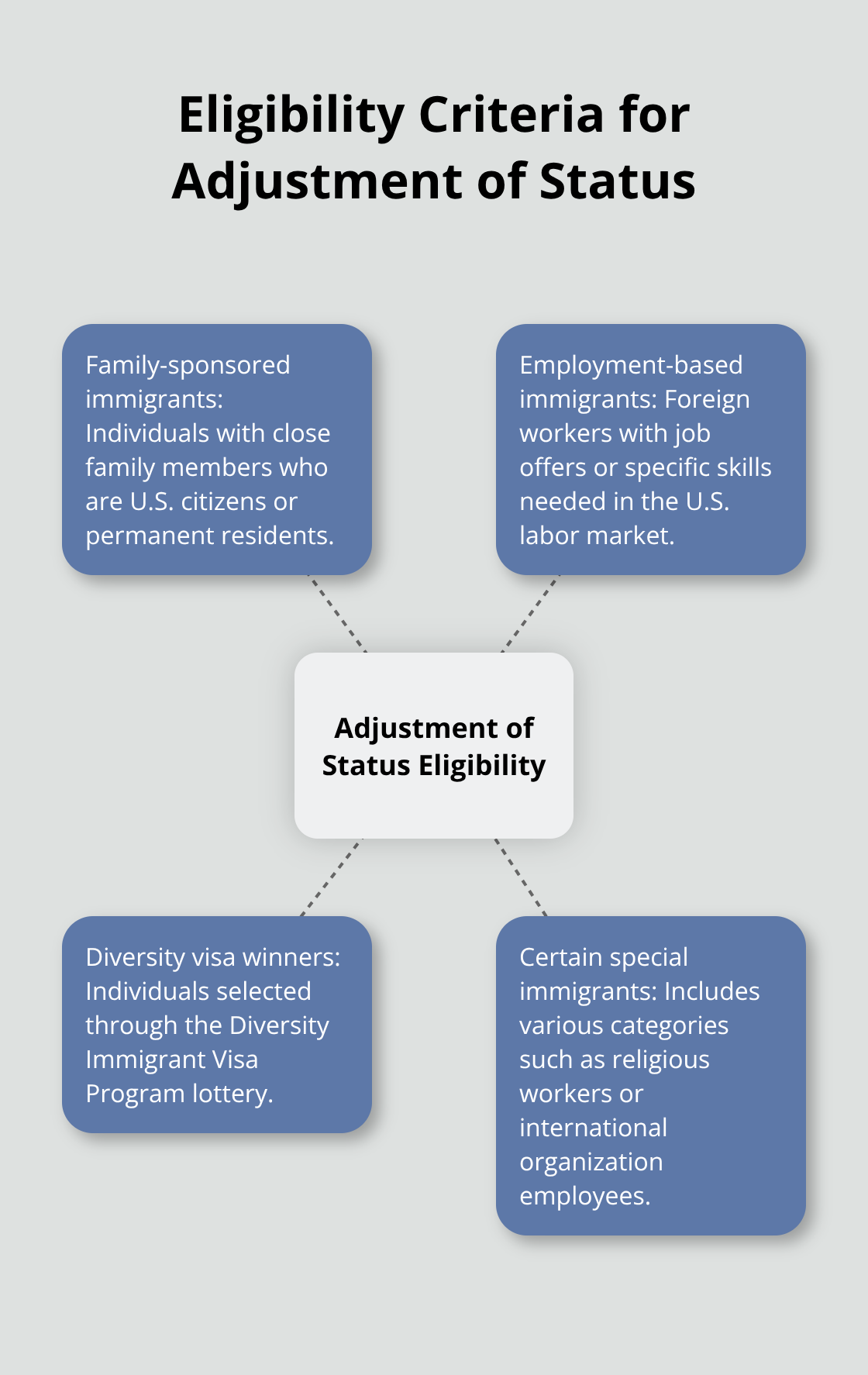
How to Navigate a Pending Adjustment of Status
Navigating a pending Adjustment of Status can be a complex and often lengthy process. Many immigrants find themselves uncertain about the steps involved and how to handle potential delays.
At Law Offices of Jeffrey A. Thompson, we understand the challenges and anxieties that come with this important immigration procedure. This guide will walk you through the key aspects of the Adjustment of Status process, helping you understand what to expect and how to address common issues that may arise.
Understanding Adjustment of Status
Definition and Purpose
Adjustment of Status is a pivotal process in U.S. immigration law. It allows eligible individuals to apply for lawful permanent resident status (green card) without leaving the United States. This procedure can significantly impact an applicant’s life and future in the country.
Eligibility Criteria
Not everyone qualifies for Adjustment of Status. It’s primarily available to those who entered the U.S. legally and maintain lawful status. Common eligible categories include:
- Family-sponsored immigrants
- Employment-based immigrants
- Diversity visa winners
- Certain special immigrants

Each case has unique circumstances. Some individuals who entered without inspection may still qualify under specific conditions, such as section 245(i) of the Immigration and Nationality Act.
Reasons for Pending Status
A pending Adjustment of Status can cause frustration, but it’s a common occurrence. Several factors contribute to this situation:
- Background checks: USCIS conducts thorough security checks, which take time.
- Visa availability: For some categories, applicants must wait until a visa number becomes available.
- Request for Evidence (RFE): USCIS may require additional documentation to process a case.
- High application volume: USCIS processing times vary based on workload.
Historical USCIS data shows the processing times for Form I-485 (Adjustment of Status application) from Fiscal Year 2020 to 2025 (up to June 30, 2025). Processing times can vary depending on the field office and case type.
Managing the Pending Period
While a case is pending, applicants must:
- Maintain valid status if possible
- Avoid international travel without proper authorization
- Keep their address updated with USCIS
- Respond promptly to any USCIS requests
Compliance with immigration laws remains paramount during the Adjustment of Status period. This includes obtaining necessary work authorization, maintaining valid status, and adhering to all USCIS guidelines.
Adjustment of Status is more than a bureaucratic process; it’s a pathway to permanent residency. Correct navigation of this process is paramount to achieving the goal of building a future in the United States.
As we move forward, we’ll explore the key steps involved in the Adjustment of Status process, providing you with a comprehensive understanding of what to expect and how to prepare for each stage.
Key Steps in the Adjustment of Status Process
The Adjustment of Status process involves several critical steps that require careful attention and preparation. This chapter outlines the main stages applicants must navigate to successfully adjust their status.
Filing Form I-485
Form I-485 serves as the foundation of the Adjustment of Status process. Applicants must complete this form accurately and submit it with all required supporting documents. Common errors include incomplete forms, missing signatures, or insufficient evidence. We recommend using the most recent version of the form from the USCIS website and reviewing all entries before submission.
Supporting documents typically include:
- Proof of eligibility
- Birth certificates
- Passport copies
- Evidence of lawful entry into the U.S.
Employment-based applicants should include job offer letters and labor certifications. Family-based applicants need to provide relationship evidence such as marriage certificates or adoption papers.
USCIS filing fees for Form I-485 can be substantial. Fee exemptions may apply for certain applicants, such as adult adoptees filing Form N-600.
Attending Biometrics Appointment
After USCIS receives your application, they will schedule you for a biometrics appointment. This involves:
- Fingerprinting
- Photographing
- Signature collection
These steps are necessary for background checks. It’s important to attend this appointment as scheduled to avoid delays in your application process.
The FBI conducts background checks using the biometric data. These checks can take anywhere from a few weeks to several months, depending on various factors. If any issues arise during the background check, USCIS may request additional information or schedule an interview.
Preparing for the USCIS Interview
Many (but not all) Adjustment of Status applicants must attend an interview with a USCIS officer. Preparation is key to a successful interview. Applicants should:
- Review their application thoroughly
- Be ready to explain any discrepancies or changes in their situation since filing
- Bring original versions of all documents submitted with the application
- Dress professionally and arrive early
- Answer questions truthfully and concisely
If you don’t understand a question, ask for clarification rather than guessing. This approach demonstrates honesty and helps avoid misunderstandings.
Responding to Requests for Evidence
USCIS may issue a Request for Evidence (RFE) if they need additional information to process your application. USCIS data provides information on the number of forms received, processed, approved, denied, and pending, along with average processing times.
RFEs have strict deadlines, usually 30 to 90 days. Failure to respond or providing an incomplete response can lead to a denial. We advise clients to address each point in the RFE thoroughly and submit a well-organized response package before the deadline.
The Adjustment of Status process can be intricate and time-consuming. While average processing times vary, USCIS data shows that most I-485 applications are processed within 8 to 14 months. However, some cases may take longer due to various factors such as visa retrogression or security concerns.

As we move forward, we’ll explore how to handle potential delays and complications that may arise during the Adjustment of Status process, providing you with strategies to navigate these challenges effectively.
Navigating Delays in Adjustment of Status
Understanding Processing Times
USCIS processing times for Form I-485 vary based on application type and service center. As of September 2025, employment-based applications take 6 to 33 months, while family-based applications range from 12 to 57 months. These timeframes fluctuate due to USCIS workload and policy changes.
Factors Extending Pending Periods
Several elements can prolong the Adjustment of Status process:
- Visa retrogression: More applicants than available visas create backlogs.
- Security checks: Extensive background investigations delay case adjudication.
- Staffing issues: USCIS workforce changes impact processing speeds.
- Policy changes: New immigration policies affect case processing.
The COVID-19 pandemic contributed to significant backlogs, with USCIS reporting an increase in pending cases from FY 2019 to FY 2021. This increase can be attributed to the full re-opening of USCIS offices and in-person services after temporary closures and reduced staffing due to the COVID-19 pandemic.
Proactive Case Follow-up Steps
Applicants can stay informed about their case status through these actions:
- Check the USCIS Case Status Online tool regularly for updates.
- Sign up for case status alerts via email or text message.
- Schedule an InfoPass appointment for cases without movement for extended periods.
- Submit a case inquiry for applications outside normal processing times.
USCIS data shows that in FY 2024, about 15% of applicants who submitted case inquiries received responses within 30 days (highlighting the importance of persistent follow-ups).

Seeking Legal Assistance
Legal help becomes necessary in specific situations:
- Receipt of a Notice of Intent to Deny (NOID) or a Request for Evidence (RFE).
- Cases pending significantly longer than posted processing times.
- Complications in immigration history or personal circumstances.
- Need to file a mandamus lawsuit to compel USCIS decision on long-pending cases.
The Law Offices of Jeffrey A. Thompson in Brockton, Massachusetts, specializes in Immigration Law. Attorney Thompson provides expert guidance in navigating the process, from paperwork to overcoming legal hurdles, helping clients achieve their American dreams.
Maintaining Valid Status
While awaiting a decision, applicants must:
- Keep their current immigration status valid (if possible).
- Avoid international travel without proper authorization.
- Update their address with USCIS promptly.
- Respond quickly to any USCIS requests.
Compliance with immigration laws remains paramount during the Adjustment of Status period. This includes obtaining necessary work authorization and adhering to all USCIS guidelines.
Final Thoughts
The Adjustment of Status process demands patience and meticulous attention to detail. Applicants must navigate complex steps, from filing Form I-485 to attending interviews, while maintaining compliance with immigration laws. A pending Adjustment of Status application often brings uncertainty, but proactive case management can help address challenges associated with extended waiting periods.
Professional legal assistance can make a significant difference for those facing complications in their immigration journey. The Law Offices of Jeffrey A. Thompson specializes in guiding clients through complex immigration matters, including Adjustment of Status applications. Our team provides the support and knowledge necessary to tackle challenging immigration cases.
Each Adjustment of Status case is unique and requires tailored approaches. With proper preparation, documentation, and legal support, applicants can successfully manage their pending Adjustment of Status. The path may be complex, but with perseverance and the right resources, individuals can move closer to realizing their immigration goals in the United States.


